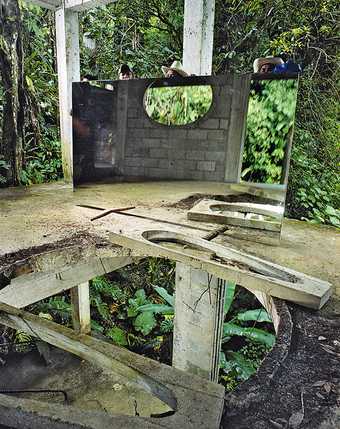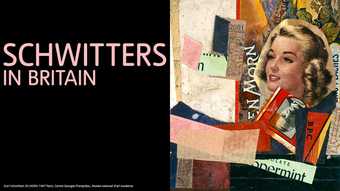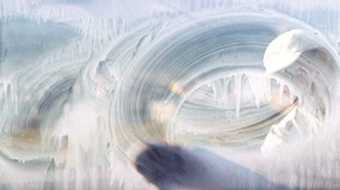I first became interested in the town of Xilitla after a trip there in 2001. I had heard about the garden called Las Pozas made by this English patron of the arts, Edward James, but as it is so far away from Mexico City I had never managed to get there. In 2009 I felt the need to shift my work from the urban context, and Xilitla provided the opportunity of still working with architecture yet in a natural environment.
James’s twenty-year investment in his oneiric, emotional architecture in such a remote place, without the need for a public, interested me. We share common nationality, but our encounter with Mexico touches very different moments within modernity. We can no longer think of the division between periphery and centre, and the romantic notion of tropical landscape now is seen through the colonial gaze. The film Xilitla 2010 had to mark those differences of generation. I was also aware that, in terms of image, that gap had to be addressed, hence the working with bluish and dark tonal ranges, as it was a question of giving the site its own peculiar atmosphere and not simply documenting the vestiges from the past.
Rafael Ortega [the filmmaker] and I made several scouting trips before taking a larger crew and doing the shoot. On these it became apparent that the traditional format would not work in Xilitla, as the site is extremely vertical and many of the structures are gothic, so the frame would have been constantly cut. The vertical format provided a conceptual rupture with the horizontality of the film frame, while at the same time echoing the architecture itself, which is non-functional and irrational by nature. The idea was to create a film that reflected the significance of Xilitla as a site today, focusing on the ruin, the monument, nature, Surrealism and entropy, as well as citing Robert Smithson’s Mirror Displacements 1969 in the Yucatan which disrupt ideas of site perception and the gaze. The presence of the mirror in the piece goes back to the pictorial and geopolitical frame, and naturally back to painting.

Film still from Melanie Smith's Xilitla 2010
Both the film and the painting series are about palimpsests, whereby there is a constant building of layers while they dismantle histories. In general, both in painting and film, I am searching for an unstable, undefined ground that creates potentials.
I never work with formal scripts, but instead build up visual sequences structured in a circular way, so that certain motifs, such as the mirror, appear repeatedly. It is always a question of following various lines of research that for me coincide at my sites of interest and result in these layers of associations and visual encounters.
Nearly all the film works with indirect sound. The audio functions as an antagonistic element to the image. I was thinking of it as a sort of continuous diary, with the use of the voiceover of our sound man and other lateral histories, such as construction noise, birds, raindrops and ticking clocks. Ursonate 1922–32 by Kurt Schwitters appears at one moment, my homage to the Merzbau, another construction in continuum. In this sense the European voice, which goes back and forwards from Spanish to English, takes a distant approach. Xilitla disassembles our preconceptions of a Western understanding of modernism – and this is a constant in my work. The tension between the different media I employ is what evokes incongruous strata of potentialities and perspectives.


